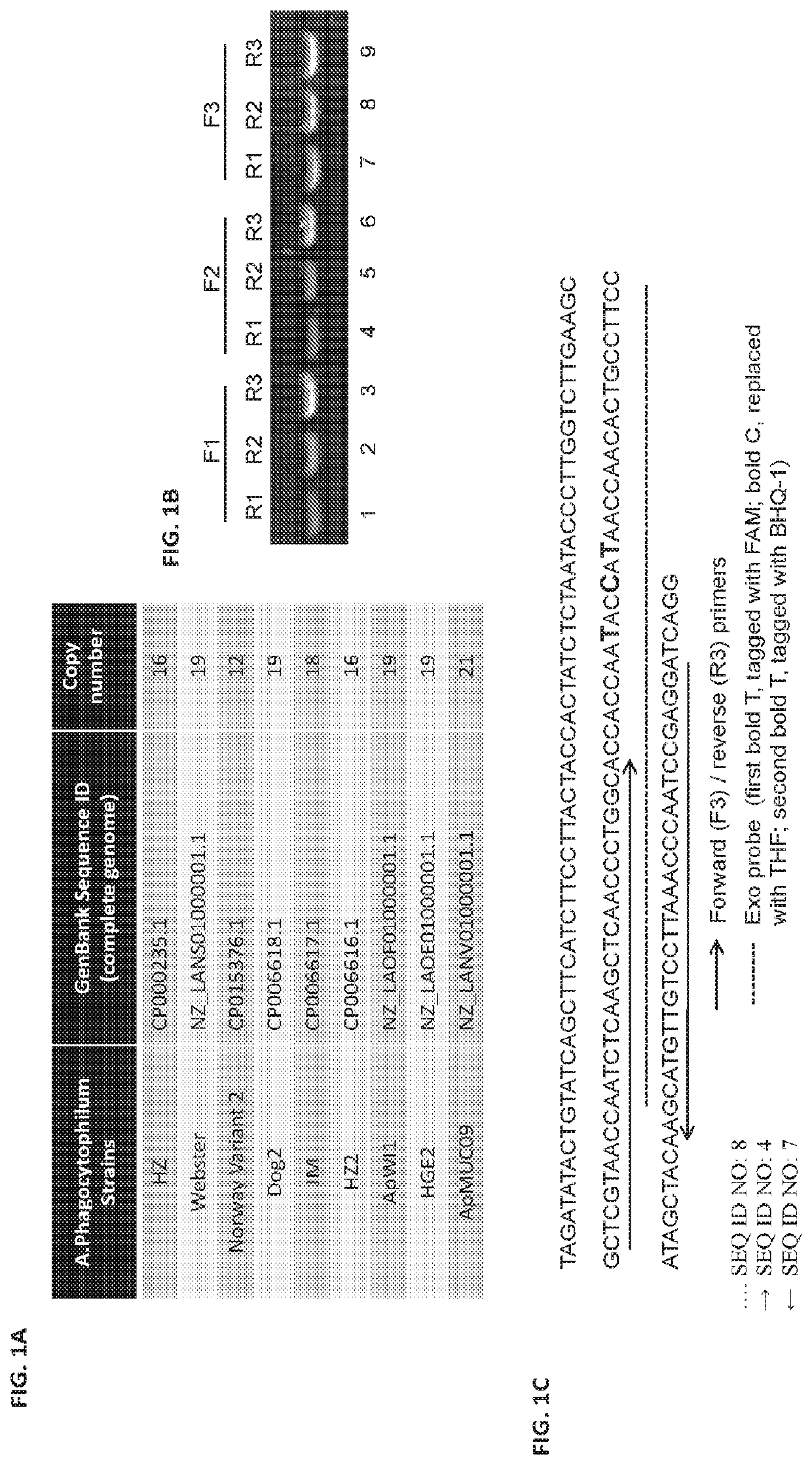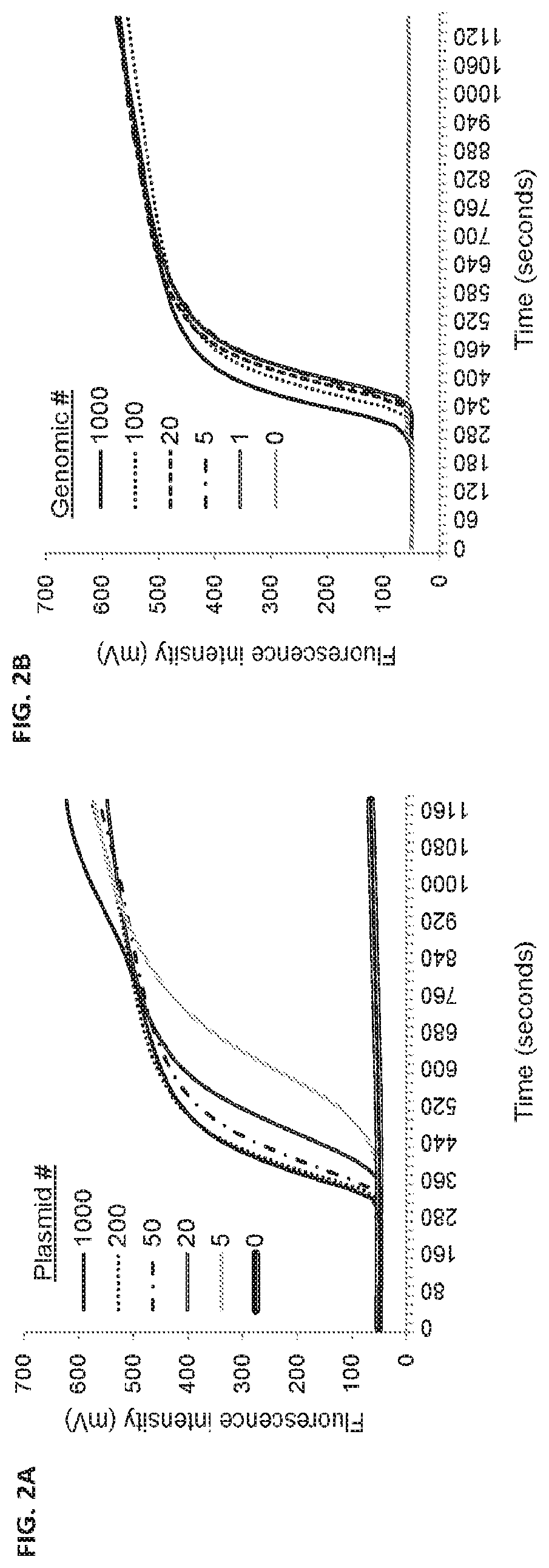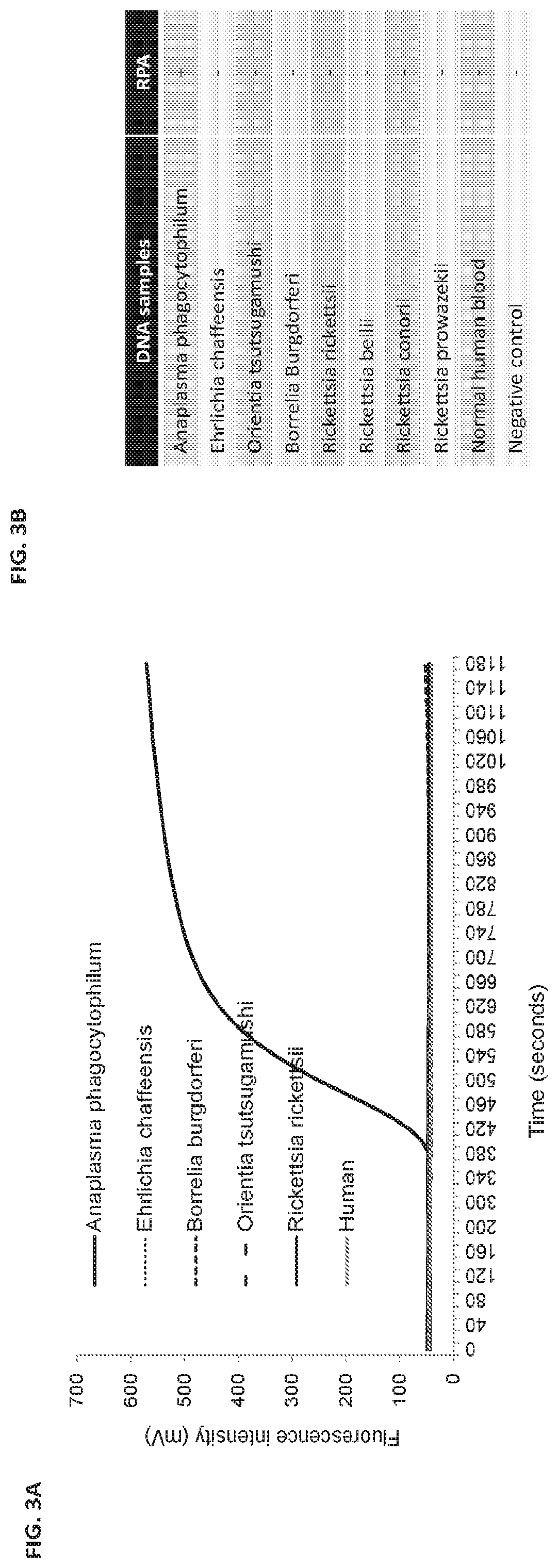Amplification assay for the detection of anaplasma phagocytophilum
a technology of anaplasma phagocytophilum and assay, which is applied in the field of assay for the detection of anaplasma phagocytophilum, can solve the problems of increasing the health risks of humans and their pets, putting significant economic burden on livestock production, and challenging clinical diagnosis of hga
- Summary
- Abstract
- Description
- Claims
- Application Information
AI Technical Summary
Benefits of technology
Problems solved by technology
Method used
Image
Examples
example 1
ation of Multicopy Sequences in A. phagocytophilum Genome and RPA Assay Design
[0104]Bioinformatics analysis of the A. phagocytophilum (HZ strain) complete genome sequence identified numerous repeated DNA fragments. One of these fragments is within the msp2 gene and has a total of 16 copies. A survey of eight other A. phagocytophilum strains with their complete genome available revealed 12 to 21 copies that share 100% sequence identity (FIG. 1A). BLAST search with other species within Anaplasma genus such as A. marginatle, A. centrale or other closely related species, such as E. chaffeensis, did not result in any significant homology. These data indicate that this 171-bp region is well conserved within strains of A. phagocytophilum, yet highly specific to A. phagocytophilum, making it an ideal target for designing molecular-detection assays. Three forward and three reverse RPA primers were designed and tested with conventional PCR for their performance (FIG. 1B and Table 1). Primers ...
example 2
Detection of the RPA Assay is One Genome Copy of A. phagocytophilum
[0105]To evaluate the performance of the RPA amplification, a reference plasmid was first generated by inserting a DNA fragment covering the RPA amplicon region. Five to 1000 copies of this plasmid in 10 μL volume were made from serial dilutions. Amplification was detected in all samples containing plasmids and our RPA assay reliably detected the presence of 5 copies of plasmid within 10 minutes of reaction (FIG. 2A). Since A. phagocytophilum Webster strain contains 19 copies of the 171-bp DNA fragment, it was expected that, in theory, the RPA assay would be sensitive enough to detect even less than 1 genome copy of A. phagocytophilum. Indeed, when various genomic copy numbers of A. phagocytophilum were used as template for RPA assay, specific amplification was observed in reactions containing 1000 to as little as 1 genomic copy of A. phagocytophilum DNA (FIG. 2B).
example 3
gocytophilum RPA Assay has High Analytical Specificity
[0106]BLAST analysis indicated that the 171-bp DNA sequence did not share significant homology with any other species even within Anaplasma genus; thus, an RPA assay on DNA from a variety of sources was performed for confirmation. As indicated in FIG. 3A and FIG. 3B, no amplification was observed when the following DNA templates were added: E. chaffeensis (Liberty strain, 1×104 copies), B. burgdorferi (B31 strain, 1×105 copies), Orientia tsutsugamushi (Karp strain, 2×104 copies), Rickettsia rickettsia (2×105 copies), Rickettsia bellii (2×105 copies), Rickettsia prowazekii (2×105 copies), Rickettsia conorii (2×105 copies) and human DNA (1×105 copies). These results indicate the A. phagocytophilum RPA assay is highly specific and does not cross-react with human DNA or any closely related bacterial DNA.
PUM
| Property | Measurement | Unit |
|---|---|---|
| Time | aaaaa | aaaaa |
| Length | aaaaa | aaaaa |
| Fluorescence | aaaaa | aaaaa |
Abstract
Description
Claims
Application Information
 Login to View More
Login to View More - R&D
- Intellectual Property
- Life Sciences
- Materials
- Tech Scout
- Unparalleled Data Quality
- Higher Quality Content
- 60% Fewer Hallucinations
Browse by: Latest US Patents, China's latest patents, Technical Efficacy Thesaurus, Application Domain, Technology Topic, Popular Technical Reports.
© 2025 PatSnap. All rights reserved.Legal|Privacy policy|Modern Slavery Act Transparency Statement|Sitemap|About US| Contact US: help@patsnap.com



